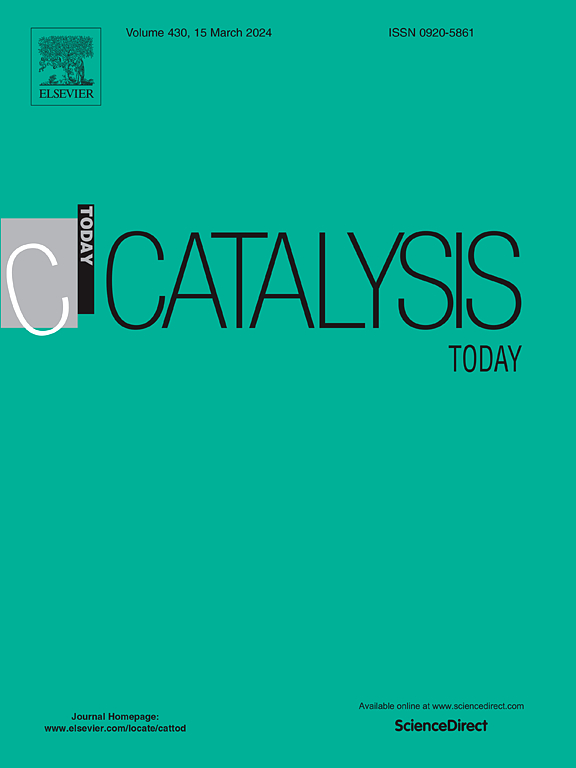Enhanced four-electron oxygen reduction reaction selectivity in atomically dispersed Fe-N-C catalysts via microwave heating
IF 5.2
2区 化学
Q1 CHEMISTRY, APPLIED
引用次数: 0
Abstract
Atomically dispersed supported iron (Fe-N-C) catalysts have emerged as the most promising alternatives to Pt-based catalysts for oxygen reduction reaction (ORR) in polymer electrolyte fuel cells (PEFCs). Advances in their synthesis over the past decade have significantly improved their activity, with some catalysts demonstrating high initial activities approaching those of commercial Pt-based catalysts. However, their practical application is hindered by durability challenge, which is facilitated by undesired formation of H2O2 via the 2e− ORR pathway. We report a strategy to improve the selectivity to the 4e− ORR pathway using microwave (MW) heating. This approach is demonstrated using Fe-N-C catalysts derived from ZIF-8. Brief heating of the Fe-N-C catalyst at 900 ºC for durations ranging from 1 s to 3 min in a single-mode microwave reactor improves its selectivity by suppressing H2O2 formation to the lowest level reported so far, while maintaining catalytic activity in ORR experiments conducted in acidic electrolytes. Characterization data indicate that MW heating reduces N and O atoms while Fe content remained at approximately 1.3 wt% after heating for ≥ 1 s. These changes were accompanied by increased basicity of Fe-N-C catalyst beyond the level reported for Fe-N-C catalysts synthesized via pyrolysis at 1050 ºC under an Ar atmosphere. We propose that MW heating selectively removes metal-free N and O sites responsible for the 2e− ORR pathway, as well as possibly Fe sites weakly bonded to the carbon framework, while preserving Fe–Nx sites held, thereby improving selectivity.
微波加热提高原子分散Fe-N-C催化剂的四电子氧还原反应选择性
原子分散负载铁(Fe-N-C)催化剂已成为聚合物电解质燃料电池(pefc)中氧还原反应(ORR)中最有前途的pt基催化剂替代品。在过去的十年中,合成技术的进步大大提高了它们的活性,一些催化剂显示出接近商业pt基催化剂的高初始活性。然而,它们的实际应用受到耐久性挑战的阻碍,这是由于H2O2通过2e - ORR途径形成的不良反应。我们报告了一种利用微波(MW)加热来提高对4e - ORR途径选择性的策略。用ZIF-8衍生的Fe-N-C催化剂证明了这种方法。在单模微波反应器中,将Fe-N-C催化剂在900℃下短暂加热1 s到3 min,将H2O2的生成抑制到目前报道的最低水平,从而提高了其选择性,同时在酸性电解质中进行的ORR实验中保持了催化活性。表征数据表明,在加热≥ 1 s后,MW加热减少了N和O原子,而Fe含量保持在约1.3 wt%。这些变化伴随着Fe-N-C催化剂的碱性增加,超过了在Ar气氛下1050℃热解合成的Fe-N-C催化剂的碱性水平。我们提出,微波加热选择性地去除负责2e - ORR途径的无金属N和O位点,以及可能与碳框架弱键合的铁位点,同时保留Fe - nx位点,从而提高选择性。
本文章由计算机程序翻译,如有差异,请以英文原文为准。
求助全文
约1分钟内获得全文
求助全文
来源期刊

Catalysis Today
化学-工程:化工
CiteScore
11.50
自引率
3.80%
发文量
573
审稿时长
2.9 months
期刊介绍:
Catalysis Today focuses on the rapid publication of original invited papers devoted to currently important topics in catalysis and related subjects. The journal only publishes special issues (Proposing a Catalysis Today Special Issue), each of which is supervised by Guest Editors who recruit individual papers and oversee the peer review process. Catalysis Today offers researchers in the field of catalysis in-depth overviews of topical issues.
Both fundamental and applied aspects of catalysis are covered. Subjects such as catalysis of immobilized organometallic and biocatalytic systems are welcome. Subjects related to catalysis such as experimental techniques, adsorption, process technology, synthesis, in situ characterization, computational, theoretical modeling, imaging and others are included if there is a clear relationship to catalysis.
 求助内容:
求助内容: 应助结果提醒方式:
应助结果提醒方式:


